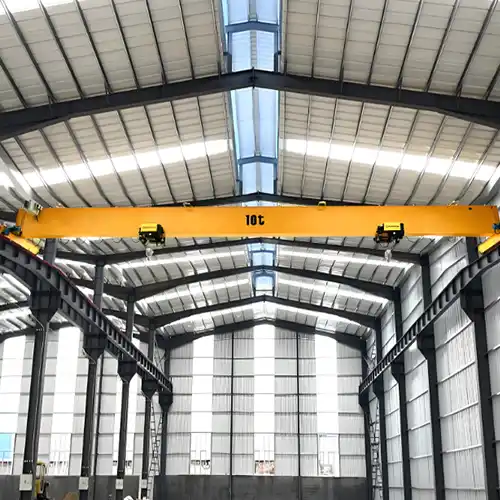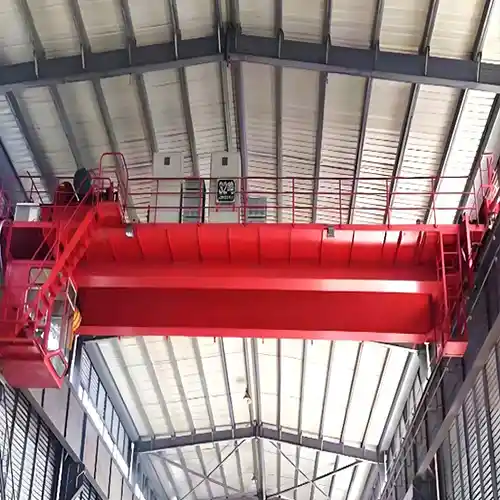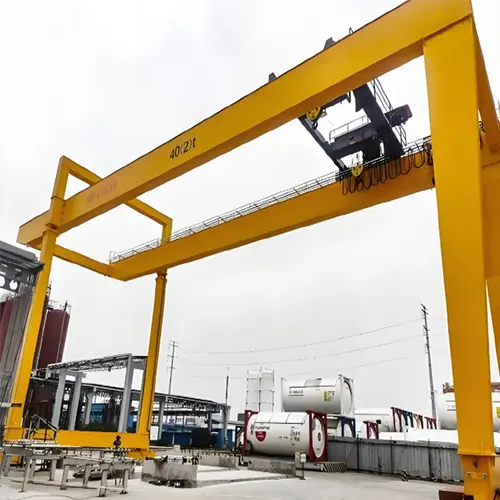Single Girder Overhead Crane with Synchronized Control Double Hoists
Single girder overhead crane with double hoists for synchronized control. Tandem operation of the double hoist overhead crane for long & large loads handling.
Category: Single Girder Overhead Crane
Your Trusted Single Girder Overhead Crane Manufacturer & Supplier
Single Girder Double Hoist Overhead Crane for Sale 1 Ton to 20 Ton
Duel Hoist Bridge Crane for Long, Heavy & Large Loads Handling with Seperate & Synchronized Control
Single girder overhead crane with double hoists for synchronized control. Tandem operation of the double hoist overhead crane for long & large loads handling.
Single girder double hoist cranes are specialized lifting devices designed to enhance load handling capabilities in various industrial environments. These cranes consist of a single horizontal beam (the girder) that supports two hoists, allowing for increased lifting efficiency and versatility.

1 ton to 20 ton single girder overhead crane with duel hoist design for long, heavy and large loads handling with synchromized operatition or seperation operation
Main specifications of double hoist overhead cranes
- The general lifting capacity of synchromized double hoist overhead crane: 1 ton to 20 ton
- lifting capacity of LDE double hoist electric crane: (5+5) ton LDE(5+2) ton , LDE(10+5) ton ,
- the span of the double hoist single girder overhead is 7.5m-31.5m, and can also be designed separately according to user requirements ,
- Crane power supply: three-phase 380V, 50Hz power supply, or customized
- working environment temperature of overhead hoist crane: -25 ℃ -40 ℃.
- Crane control: The operation mode is ground operation, remote control, and indoor operation, which are selected by the user.
The electric hoist is used as the lifting mechanism in this double electric hoist crane. The overhead crane is supported by two rail-traveling end carriages, and the two independent electric hoists are suspended on the lower flange of the single-girder crane beam girder. To meet the various loads handling operations, these two electric hoists can be operated independently or synchronized. It is a very cost-effective method of transporting long and heavy loads. As a result, it is a cost-effective and affordable new type of hoist crane.
- Bridge frame: a box-shaped girder welded by U-shaped steel plate processing and beam steel.
- The double hoist trolley is ideal for lifting long objects (such as utility poles, steel pipes, pipe piles, etc.).
- The operating mechanism of large and small vehicles: it is made up of three rotation modes in one.
Key Features
- Single Girder Design: The crane's single girder structure provides a lightweight and compact solution, making it ideal for facilities with limited headroom. This design allows for effective use of vertical space while maintaining structural integrity.
- Dual Hoists: Equipped with two hoists, these cranes can lift heavier and larger loads simultaneously or separately, increasing operational flexibility. This feature is particularly beneficial for handling oversized materials in manufacturing, construction, and logistics.
- High Capacity: Depending on the model, single girder double hoist cranes can handle capacities typically ranging from a few tons to over 20 tons. This makes them suitable for a variety of heavy-duty applications.
- Customizable Options: Many models offer customization options, including advanced control systems, wireless remote operation, and safety features like load moment indicators and anti-collision devices. This allows businesses to tailor the crane to their specific operational needs.
- Compliance with Standards: These cranes are designed to meet industry standards, ensuring safety and reliability in operations. They often comply with national and international regulations, which is crucial for maintaining workplace safety.
Benefits
- Increased Efficiency: The dual hoist capability allows for quicker handling of heavy loads, reducing downtime and improving productivity in the workplace.
- Versatility: Single girder double hoist cranes are adaptable for various applications, including manufacturing, warehousing, and construction, making them a valuable asset across different sectors.
- Enhanced Safety: With features designed to prevent overloads and ensure safe operation, these cranes contribute to a safer working environment for operators and surrounding personnel.
- Space Optimization: The single girder design minimizes the crane's footprint while maximizing lifting height, making it ideal for facilities where space is a constraint.
In summary, single girder double hoist cranes are a robust and efficient solution for handling heavy loads in various industrial applications. Their unique design and customizable features make them a popular choice for businesses looking to enhance their lifting capabilities.
Popular Types of Single Girder Double Hoist Overhead Cranes for Tandem or Separate Lifting
Double hoist single girder overhead cranes are designed to efficiently lift and maneuver heavy and oversized loads in various industrial settings. These cranes utilize a single girder structure combined with two hoists, offering enhanced versatility and capacity.
HDE Type Double Hoist Single Girder Overhead Crane: The HDE type is top-running overhead crane designed specifically for handling long, large, and heavy loads, with a lifting capacity of up to 20 tons. This crane is based on a European style single girder design and can be customized with advanced smart features to enhance functionality and efficiency. Its modern design makes it highly recommended for applications requiring sophisticated lifting solutions.
LDE Type Eectric Single-Girder Overhead Cranes are also known as double trolley or duel hoist single girder overhead cranes, among other names. The JB/T306-compliant double hoist single girder crane is designed and manufactured. It is based on the market's and users' requirements in recent years. The LD type general use single girder overhead crane is the foundation for the double hoist overhead crane. is widely used for workshop or facility with large headroom.

European Style
This crane features a sleek and modern design focused on efficiency and space optimization.
Advantages:
- High lifting capacities with minimal headroom.
- Incorporates advanced safety features and controls.
- Ideal for facilities with height constraints.
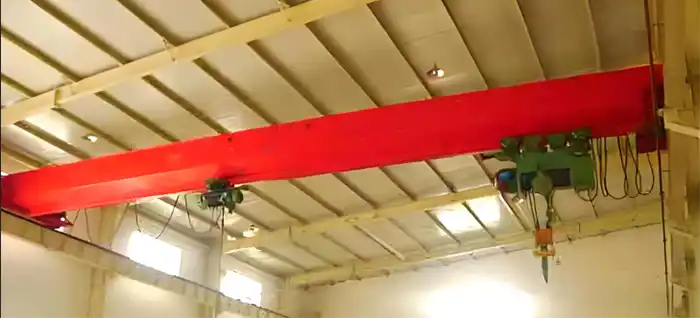
Traditional Style
Known for its robust construction, the traditional style crane offers reliability and straightforward design.
Advantages:
- Heavier frame suitable for various industrial applications.
- Proven durability and dependable performance.
- Well-suited for environments where heavy loads need to be handled efficiently.
Specialized Design Double Hoist Single Girder Overhead Crane
The specialized design double hoist single girder overhead crane is engineered to meet specific lifting needs while incorporating advanced features for enhanced safety and efficiency. This crane is particularly beneficial in environments where space constraints and hazardous conditions are present.
Low Headroom Design
This design minimizes the vertical height required for installation, allowing for greater lifting capabilities within limited overhead space.
Benefits:
- Maximizes usable space in workshops or warehouses.
- Enables higher lifting heights without compromising the crane's stability.
- Ideal for facilities with low ceilings or limited headroom.
Explosion-Proof Design
Specifically constructed to operate safely in hazardous environments, this design features components that prevent ignition in explosive atmospheres.
Benefits:
- Ensures compliance with industry safety regulations for hazardous materials.
- Protects operators and equipment from potential hazards in environments like oil refineries and chemical plants.
- Maintains reliable operation while safeguarding against explosions.
This specialized double hoist crane is perfect for industries such as manufacturing, warehousing, and construction, where both headroom limitations and safety concerns are critical. Its combination of low headroom and explosion-proof features makes it a versatile solution for complex lifting tasks in challenging environments.
Optional Features of Double Hoist Overhead Cranes
Single girder double hoist overhead cranes can be equipped with various optional features to enhance their functionality, safety, and ease of operation. Here are some notable options:
Wireless Remote-Controlled Double Hoist Crane
This feature allows operators to control the crane from a distance using a wireless remote.
Benefits:
- Increased Safety: Operators can maintain a safe distance from heavy loads and potential hazards.
- Flexibility: Improves visibility and control during lifting operations, especially in complex environments.
- Ease of Use: Simplifies operation with user-friendly controls that can be easily managed from various locations.
PLC Control for Double Hoist Single Girder Overhead Cranes
Programmable Logic Controllers (PLCs) automate the crane's lifting operations, allowing for precise control of the hoists.
Benefits:
- Enhanced Automation: Reduces manual intervention, streamlining operations and minimizing human error.
- Customizable Operations: Operators can program specific lifting sequences and parameters tailored to their operational needs.
- Data Monitoring: Provides real-time feedback and monitoring capabilities, enabling better management of lifting tasks and maintenance scheduling.
These optional features significantly improve the efficiency and safety of single girder double hoist overhead cranes, making them suitable for a wide range of industrial applications. By incorporating advanced technologies like wireless controls and PLC systems, these cranes enhance operational flexibility and adaptability to various lifting challenges.
Design and Components
Structural Components
The structural integrity of a double hoist single girder crane is paramount for safe and efficient operation. Key components include:
- Single Girder Structure: The single girder design serves as the backbone of the crane. It typically consists of a strong, horizontal beam that supports the hoists and provides stability during lifting operations. This design minimizes weight while maximizing strength, allowing for spans that can accommodate large work areas.
- Hoist Mechanism: Each hoist is equipped with a powerful electric motor, pulleys, and a hook or attachment for lifting. The dual hoists allow for simultaneous lifting or independent operation, depending on the task at hanThis flexibility enhances productivity, especially in environments where heavy or oversized loads must be managed frequently.
- End Trucks and Rails: End trucks are mounted on either side of the crane, enabling it to traverse along the rails. These trucks facilitate smooth movement and stability, reducing wear and tear on components. The rails are typically mounted on overhead supports, providing a solid pathway for the crane to operate efficiently.
Double Hoist Configuration
The double hoist configuration is a distinctive feature that enhances the crane's capabilities:
- Advantages of Dual Hoists: With two hoists, the crane can lift heavier loads than a single hoist configuration. This allows for the handling of large machinery, steel beams, or substantial materials that require extra support. Additionally, having two hoists enables the crane to perform complex maneuvers, such as lifting and positioning large items with greater precision.
- Load Distribution and Stability: The dual hoist system ensures that the weight is evenly distributed across the girder. This distribution reduces stress on the structural components and enhances overall stability during lifting operations. It also minimizes the risk of tipping or swaying, providing operators with greater confidence in safety.
Materials Used in Construction
The materials chosen for construction significantly impact the crane's durability and performance:
- Steel Grades and Treatments: High-quality steel is essential for the structural components of the crane. Different grades of steel are selected based on strength and weight requirements. Treatments such as galvanizing or powder coating may be applied to enhance durability and protect against wear and tear.
- Corrosion Resistance Features: Given that cranes often operate in harsh environments, incorporating corrosion-resistant materials is vital. Special coatings and treatments can protect the crane from rust and degradation, extending its lifespan and reducing maintenance costs. This is particularly important in industries like construction and manufacturing, where cranes are frequently exposed to moisture and chemicals.
This detailed exploration of design and components provides a solid foundation for understanding the functionality and reliability of double hoist single girder overhead cranes. If you'd like to continue with more sections or need further adjustments, let me know!
Crane Control of Double Hoist Electric Single Girder Cranes
Double hoist electric single girder cranes offer versatile control options that enhance operational efficiency and safety when handling a variety of loads. Their design allows for two distinct modes of operation: synchronized tandem lifting and separate operation.
Synchronized Operation for Tandem Lifting
Hoist Synchronization for Optimized Load Handling: It can be essential to run both main hoists simultaneously or simultaneously to realize a tandem operation if an overhead crane with a single girder has two or more main hoists. When the hoisting synchronization mode is in use, both the overhead hoists run and stop simultaneously to keep the load's alignment as it was before the hoisting started. One operator interface concurrently moves two electric travelling hoists in the same direction and at the same speed.
In scenarios where heavy or oversized loads are involved, synchronized operation is crucial. This mode enables both hoists to lift the load simultaneously, ensuring:
- Balanced Load Distribution: The dual hoist system distributes weight evenly across the main beam, reducing stress and enhancing stability during lifting. This balance minimizes the risk of tipping or swaying, particularly when handling long or wide objects.
- Improved Control: With synchronized lifting, operators can maneuver large loads more effectively, making precise adjustments during transport. This capability is particularly beneficial in manufacturing and construction environments where exact positioning is essential.
- Increased Safety: The ability to lift heavy loads with both hoists reduces the strain on individual components, lowering the likelihood of equipment failure. This safety feature is critical in maintaining safe operational practices.
Separate Operation for General Load Handling
In addition to tandem lifting, double hoist cranes can operate hoists independently, which is advantageous for handling general objects or lighter loads. This mode allows for:
- Flexibility in Operations: Operators can use one hoist for lighter items while the other hoist remains idle, maximizing the crane's utility. This flexibility is particularly useful in environments with varying load requirements.
- Adaptability for Diverse Applications: Separate operation is ideal for tasks that involve different types of loads that do not require the strength of dual hoists. This allows for more efficient handling of everyday materials, such as tools, parts, or machinery.
- Operational Efficiency: By allowing for separate lifting tasks, the crane can be used continuously without the need to switch out loads or pause operations. This adaptability improves overall workflow and productivity in the workplace.
In conclusion, the control features of double hoist electric single girder cranes provide operators with the ability to perform synchronized tandem lifts for heavy loads, while also allowing for separate operations for general handling tasks. This versatility enhances efficiency, safety, and flexibility in various industrial applications, making these cranes an essential component in modern material handling solutions. If you need more information or specific details, feel free to ask!
When and Why Double Hoist Single Girder Overhead Cranes Are Adopted
When the double hoist overhead crane needs to be equipped with two electric hoists, the following items should be considered.The capacity of two electric hoists does not exceed the design capacity of the double hoist crane. That is, if you want to hang two 1 Ton electric hoists, the lifting capacity of the double hoist crane should be 2 ton or greater.If the total lifting capacity of the double hoist crane is greater than or equal to 1Ton, the reconstruction must be carried out by an enterprise with the necessary qualifications.Anti-collision system. For double hoist overhead cranes, the anti-collision devices are needed to ensure the crane operation safety.If the lifting item is long, it can be designed with a single switch that can be used simultaneously or individually.Contact us to get your custom designed double hoist overhead cranes and double hoist gantry crane.
Double hoist single girder overhead cranes are adopted in specific scenarios that demand enhanced lifting capabilities and operational flexibility. They are particularly beneficial in the following circumstances:
- Heavy and Oversized Loads: When projects require lifting heavy or oversized materials, such as large machinery, steel beams, or construction components, double hoist cranes provide the necessary support and strength to safely handle these loads.
- Long Loads: In industries where long materials need to be maneuvered, such as steel fabrication or construction, the dual hoists enhance balance and control. This configuration is ideal for handling items like pipes, girders, or other lengthy materials.
- Complex Operations: In manufacturing or assembly environments where multiple components need to be lifted simultaneously or precise positioning is required, double hoist cranes allow for independent or coordinated lifting. This flexibility improves efficiency in processes where timing and accuracy are critical.
- Increased Efficiency: In high-demand environments, the ability to lift and move loads more quickly and safely contributes to overall productivity. The use of dual hoists can reduce the time spent on material handling, accelerating workflows.

Main Functions of Single Girder Overhead Crane with Dual Hoists
- Enhanced Lifting Capacity: The dual hoist system allows for significantly increased lifting capacity, enabling the crane to handle heavier loads than a single hoist configuration.
- Improved Load Distribution: By utilizing two hoists, the weight of the load is evenly distributed across the girder. This reduces stress on the crane and enhances overall stability during lifting operations.
- Versatility in Operations: Dual hoists provide flexibility, allowing for simultaneous lifting or independent operation. This versatility is especially useful in dynamic environments where different lifting requirements may arise.
- Increased Precision: The ability to control two hoists allows for more precise handling of large and heavy loads, facilitating tasks that require meticulous placement and maneuvering.
Typical Applications or Lifting Requirements
Double hoist single girder overhead cranes are particularly advantageous in situations where:
- Long Loads: When handling elongated items, such as steel beams or large panels, dual hoists provide better balance and support, minimizing the risk of bending or tipping.
- Heavy Equipment: In industries like manufacturing and construction, these cranes are essential for lifting and positioning heavy machinery, such as generators, presses, or large fabrication tools.
- Complex Assembly Tasks: In assembly lines or fabrication workshops, dual hoists enable the simultaneous lifting of multiple components, streamlining the assembly process for large products.
Typical Load Handling Applications
Double hoist single girder overhead cranes are specifically required for:
- Heavy Loads: These cranes are designed to handle loads ranging from 1 tons to 20 tons, depending on the specific model and configuration. They are essential for lifting heavy machinery, steel structures, or large components.
- Large Loads: When dealing with oversized items that require extra support, such as large metal sheets or precast concrete elements, the dual hoist system ensures safe and efficient handling.
- Long Loads: The dual hoist setup is particularly useful for long, unwieldy items like pipes or beams, as it enhances control and stability during movement, allowing for safer transportation across workshops or job sites.
In summary, double hoist single girder overhead cranes are indispensable in industries where heavy, long, and large loads need to be lifted and positioned with precision and safety. Their design allows for enhanced lifting capabilities and improved operational efficiency in a variety of applications. If you need more details or further elaboration, feel free to ask!
Benefits of Single Girder Overhead Cranes with Dual Hoists
The adoption of double hoist single girder overhead cranes brings several distinct advantages:
- Higher Lifting Capacity: With two hoists working in tandem, these cranes can lift heavier loads compared to single hoist systems. This makes them suitable for applications that require handling loads over 10 tons or more.
- Improved Load Stability: Dual hoists help distribute the load evenly across the girder, reducing the risk of tipping or swaying. This stability enhances safety during lifting operations, particularly with heavy or awkwardly shaped loads.
- Operational Flexibility: Operators can utilize the hoists independently or together, providing the flexibility to adapt to varying lifting requirements. This feature is particularly advantageous in dynamic work environments where load types and sizes frequently change.
- Increased Precision: The ability to control two hoists allows for greater precision in lifting and positioning. This is especially important in assembly processes where accurate placement is essential for safety and functionality.
- Enhanced Safety Features: The presence of dual hoists often comes with additional safety features, such as overload protection and anti-collision devices, which help prevent accidents and ensure safe operation in busy work environments.
- Cost-Effectiveness: By reducing the need for multiple cranes and enabling efficient handling of heavy loads, double hoist single girder cranes can lead to cost savings in operations, maintenance, and labor.
In summary, double hoist single girder overhead cranes are adopted in scenarios that require enhanced lifting capabilities, improved safety, and operational efficiency. Their benefits make them a valuable investment for industries that frequently handle heavy, oversized, or long loads. If you have more specific areas you'd like to explore or further details needed, just let me know!
Applications
Industries Utilizing Double Hoist Single Girder Cranes
Double hoist single girder overhead cranes are essential in various industries due to their capability to handle long, heavy, and large loads. Their versatility makes them ideal for numerous applications, ensuring efficient and safe material handling.
Double hoist single girder overhead cranes play a crucial role in various industries, facilitating the movement and handling of heavy and oversized loads. Below is a detailed overview of their applications, typical load handling capacities, and specific use cases.
Manufacturing
In manufacturing, double hoist cranes are essential for transporting raw materials, components, and finished products within production lines. Their robust design allows for high lifting capacities, making them ideal for handling heavy and bulky items.
Typical Applications:
- Moving Heavy Machinery: These cranes efficiently transport large equipment within workshops.
- Lifting Large Sheets: Ideal for handling sheets of metal or composite materials during production.
- Assembling Large Components: Frequently used for tasks like assembling engine parts or structural frames.
Typical Load Handling: Loads generally range from 5 tons to over 20 tons, depending on the specific needs of the manufacturing process.
Construction
In the construction sector, double hoist single girder cranes are vital for lifting and positioning heavy materials, contributing to smooth and safe project execution.
Typical Applications:
- Lifting Steel Beams: Crucial for transporting and positioning steel beams and concrete panels.
- Handling Heavy Machinery: Used during site setup to move equipment like excavators and concrete mixers.
- Supporting Large Projects: Essential for operations on large construction sites and high-rise buildings.
Typical Load Handling: These cranes typically manage loads exceeding 10 tons, accommodating the substantial weights of construction materials.
Warehousing and Distribution
In warehousing and distribution centers, double hoist cranes streamline the movement of goods, optimizing storage and retrieval processes.
Typical Applications:
- Loading and Unloading: Used for handling shipping containers and large pallets efficiently.
- Moving Heavy Inventory: Facilitates the transfer of inventory from storage to dispatch areas.
- Supporting Assembly Lines: Assists in the assembly processes within distribution centers.
Typical Load Handling: Loads can range from 2 tons to over 15 tons, depending on the nature and size of the inventory.
Specific Use Cases
Double hoist single girder cranes excel in several specialized scenarios, showcasing their capabilities in heavy and precise lifting.
Heavy Machinery Handling
These cranes are crucial for safely lifting and moving heavy machinery during installation or maintenance. They are often employed to position large industrial machines in manufacturing plants or to relocate equipment on construction sites, handling weights that can exceed 20 tons.
Large Assembly Processes
In assembly plants, these cranes support the assembly of large products, such as vehicles and heavy machinery. They enable the precise placement of components, ensuring efficient movement and assembly of large parts. Typical applications include the assembly of aircraft wings and the large-scale manufacturing of shipping containers, where loads can reach several tons.
Safety Features of Double Hoist Single Girder Overhead Cranes
The safety of operators and equipment is paramount in the operation of double hoist single girder overhead cranes. To minimize risks and enhance operational reliability, several safety features are integrated into their design and operation.
Overload Protection
Overload protection systems are vital for preventing cranes from lifting loads that exceed their rated capacity. Key components include:
- Load Limit Switches: Automatically cut off power to the hoist when an overload condition is detected, protecting the crane and operators from potential harm.
- Visual and Audible Alerts: Alarms and indicators notify operators when approaching overload conditions, enabling timely corrective actions.
Emergency Stop Mechanisms
Emergency stop mechanisms ensure that crane operations can be quickly halted in emergencies. These include:
- E-Stop Buttons: Strategically placed buttons allow for immediate cessation of all crane movements, reducing risks during unexpected situations.
- Remote Emergency Stops: Some systems feature remote emergency stop capabilities, allowing personnel to halt operations from a safe distance.
Anti-Collision Devices
Anti-collision devices are essential for preventing accidents when multiple hoists operate in close proximity. Key features consist of:
- Hoist Traveling Limits: These devices establish predefined travel limits for each hoist, preventing collisions, particularly when both are lifting long loads simultaneously.
- Proximity Sensors: Sensors detect the positions of the hoists and alert operators if they approach too closely, allowing for timely interventions before collisions occur.
By incorporating these safety features, including overload protection, emergency stop mechanisms, and anti-collision devices, and by adhering to recognized standards, double hoist single girder overhead cranes can operate efficiently while prioritizing the safety and well-being of operators and minimizing workplace hazards. If you require further modifications or additional details, feel free to ask!
Send us An Inquiry to Get Your Customized Single Girder Cranes
In summary, double hoist single girder overhead cranes are essential tools in various industries, offering enhanced lifting capabilities, safety features, and operational efficiency. Their design allows for handling heavy and large loads, making them invaluable in manufacturing, construction, and warehousing. Key safety mechanisms, including overload protection, emergency stop features, and anti-collision devices, ensure reliable and safe operation.
As industries continue to evolve, overhead crane technology is expected to advance significantly. Trends may include increased automation, smarter control systems, and the integration of IoT (Internet of Things) for real-time monitoring and predictive maintenance. These innovations will further enhance safety, efficiency, and productivity in crane operations.
To maximize operational effectiveness and ensure worker safety, industries should consider adopting double hoist single girder overhead cranes in their facilities. Investing in modern crane systems not only improves handling capabilities but also aligns with future technological advancements, positioning businesses for success in an increasingly competitive market.
Related Products: Types of Overhead Cranes for Tandem Lifting
![Double hoist overhead crane Double hoist overhead crane]()
![Double hoist gantry crane Double hoist gantry crane]()
![Double Trolley Overhead Crane Double Trolley Overhead Crane]()
![Double girder gantry crane Double girder gantry crane]()
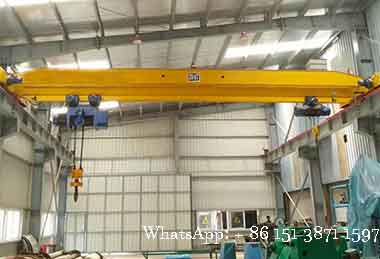
Tandem opeation double hoist overhead crane with single girder overhead crane design is used for light loads, for long and large loads handling such as, pipe, beam, or steel beam, etc.

Synchronized control double hoist gantry crane with single girder gantry crane design, equipped with two electric hoists for long, large and heavy loads handling indoor use or outdoor applications.

QE double girder overhead crane with double trolley 5 ton to 220 ton for sale. Double Trolley Overhead Crane,top running bridge crane usually consists of two trolleys of equal lifting capacity, which can work simultaneously or separately. They are mainly used to lift long and big loads or sets of loads with two long distance lifting points.

Double girder gantry crane with double hoist trolley for outdoor application for large, long or heavy loads handling. And rainproof cover is equipped to ensure your double hoist gantry crane safety.
Main Projects
Related Products

Supplied three grab bucket crane kits to Indonesia, enhancing garbage handling efficiency with high load capacity and reliable performance.
Free consultation to Confirm Parameters & Specifications and Get
Latest Crane Price & Crane Rate.
- Types of overhead cranes : _______?
- Optional: Overhead travelling crane, goliath gantry crane,Slewing jib crane, Single girder or double girder crane,small portable crane or kbk crane, etc.
- Capacity of overhead crane: _______?
- Optional: 0.25ton, 0.5 ton, 1 ton, 2 ton, 3ton, 5 ton, 10 ton,15ton, 20ton, 25 ton, 30ton,35ton, up to 550ton, etc.
- Crane span & lifting height : _______?
- Crane travelling length : _____?
- Control of overhead crane:_______?
- Optional: pendant/ remote/cabin control
- Voltage supply of overhead crane:_____?
- Eg,: 380V50/60HZ,3Phase or others,etc.
- Application/usage of crane:_______?
- Eg,: Steel mill, ,injection mold, cement,stone, concrete,granite, general manufacturing, etc.
Just leave a message via the contact form and our hoist and crane engineer will contact you with in 24working hours.
Get In Touch
